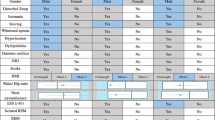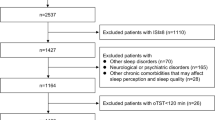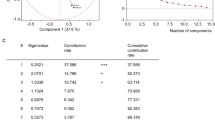Abstract
Purpose
The upper airway (UA) anatomical collapsibility, UA muscle responsiveness, breathing control, and/or arousability are important contributing factors for obstructive sleep apnea (OSA). Differences in clinical manifestations of OSA are believed to reflect interactions among these factors. We aimed to classify OSA patients into subgroups based on polysomnographic (PSG) variables using cluster analysis and assess each subgroup’s characteristics.
Methods
Men with moderate or severe OSA and without any concomitant heart or psychosomatic disease were recruited. A hierarchical cluster analysis was performed using variables including fraction of apnea, respiratory event duration, minimum oxygen saturation, arousal rate before termination, and frequency of respiratory events in the supine position. The impact of sleep stages or body position on PSG variables was also evaluated in each cluster.
Results
A total of 210 men (mean age, 50.0 years, mean body mass index, 27.4 kg/m2) were studied. The three subgroups that emerged from the analysis were defined as follows: cluster 1 (high fraction of apnea and severe desaturation (20%)), cluster 2 (high fraction of apnea and long event duration (31%)), and cluster 3 (low fraction of apnea (49%)). There were differences in the body mass index and apnea type between the three clusters. Sleep stages and/or body position affected PSG variables in each cluster.
Conclusions
Patients with OSA could be divided into three distinct subgroups based on PSG variables. This clustering may be used for assessing the pathophysiology of OSA to tailor individual treatment other than continuous positive airway pressure therapy.




Similar content being viewed by others
Abbreviations
- AHI:
-
Apnea-hypopnea index
- BMI:
-
Body mass index
- CA:
-
Central apnea
- EMG:
-
Electromyogram
- Fapnea :
-
Fraction of apnea
- OSA:
-
Obstructive sleep apnea
- PSG:
-
Polysomnography
- Rar :
-
Ratio of arousal
- SDB:
-
Sleep-disordered breathing
- SE:
-
Standard error
- SN:
-
Distance from sella to nasion
- SpO2 :
-
Saturation of oxygen
- UA:
-
Upper airway
References
American Academy of Sleep Medicine (2014) International classification of sleep disorders: diagnostic and coding manual, 3rd edn. American Academy of Sleep Medicine, Darien
Wellman A, Eckert DJ, Jordan AS, Edwards BA, Passaglia CL, Jackson AC, Gautam S, Owens RL, Malhotra A, White DP (2011) A method for measuring and modeling the physiological traits causing obstructive sleep apnea. J Appl Physiol (1985) 110:1627–1637
Edwards BA, Wellman A, Owens RL (2013) PSGs: more than just the AHI. J Clin Sleep Med 9:527–528
Punjabi NM (2016) COUNTERPOINT: is the apnea-hypopnea index the best way to quantify the severity of sleep-disordered breathing? No. Chest 149:16–19
Joosten SA, Hamza K, Sands S, Turton A, Berger P, Hamilton G (2012) Phenotypes of patients with mild to moderate obstructive sleep apnoea as confirmed by cluster analysis. Respirology 17:99–107
Ye L, Pien GW, Ratcliffe SJ, Bjornsdottir E, Arnardottir ES, Pack AI, Benediktsdottir B, Gislason T (2014) The different clinical faces of obstructive sleep apnoea: a cluster analysis. Eur Respir J 44:1600–1607
Bailly S, Destors M, Grillet Y, Richard P, Stach B, Vivodtzev I, Timsit JF, Levy P, Tamisier R, Pepin JL, registry(OSFP) sciotFnsa (2016) Obstructive sleep apnea: a cluster analysis at time of diagnosis. PLoS One 11:e0157318
Vavougios GD, George DG, Pastaka C, Zarogiannis SG, Gourgoulianis KI (2016) Phenotypes of comorbidity in OSAS patients: combining categorical principal component analysis with cluster analysis. J Sleep Res 25:31–38
Lacedonia D, Carpagnano GE, Sabato R, Storto MM, Palmiotti GA, Capozzi V, Barbaro MP, Gallo C (2016) Characterization of obstructive sleep apnea-hypopnea syndrome (OSA) population by means of cluster analysis. J Sleep Res 25:724–730
Zinchuk AV, Jeon S, Koo BB, Yan X, Bravata DM, Qin L, Selim BJ, Strohl KP, Redeker NS, Concato J, Yaggi HK (2018) Polysomnographic phenotypes and their cardiovascular implications in obstructive sleep apnoea. Thorax 73:472–480
Iber C, Ancoli-Israel S, Chesson AL, Quan SF (2007) The AASM Manual for the scoring of sleep and associated events: rules, terminology, and technical specifications. American Academy of Sleep Medicine, Westchester
Edwards BA, Eckert DJ, McSharry DG, Sands SA, Desai A, Kehlmann G, Bakker JP, Genta PR, Owens RL, White DP, Wellman A, Malhotra A (2014) Clinical predictors of the respiratory arousal threshold in patients with obstructive sleep apnea. Am J Respir Crit Care Med 190:1293–1300
Penzel T, Moller M, Becker HF, Knaack L, Peter JH (2001) Effect of sleep position and sleep stage on the collapsibility of the upper airways in patients with sleep apnea. Sleep 24:90–95
Dolnicar S (2002) A review of unquestioned standards in using cluster analysis for data-driven market segmentation. In: the Australian and New Zealand Marketing Academy Conference 2002 (ANZMAC 2002); 2002 2–4 December 2002; Deakin University, Melbourne
Watson PF, Petrie A (2010) Method agreement analysis: a review of correct methodology. Theriogenology 73:1167–1179
Jordan AS, Wellman A, Edwards JK, Schory K, Dover L, MacDonald M, Patel SR, Fogel RB, Malhotra A, White DP (2005) Respiratory control stability and upper airway collapsibility in men and women with obstructive sleep apnea. J Appl Physiol (1985) 99:2020–2027
Patil SP, Schneider H, Marx JJ, Gladmon E, Schwartz AR, Smith PL (2007) Neuromechanical control of upper airway patency during sleep. J Appl Physiol (1985) 102:547–556
Schwartz AR, O’Donnell CP, Baron J, Schubert N, Alam D, Samadi SD, Smith PL (1998) The hypotonic upper airway in obstructive sleep apnea: role of structures and neuromuscular activity. Am J Respir Crit Care Med 157:1051–1057
Joosten SA, Edwards BA, Wellman A, Turton A, Skuza EM, Berger PJ, Hamilton GS (2015) The effect of body position on physiological factors that contribute to obstructive sleep apnea. Sleep 38:1469–1478
Oksenberg A, Arons E, Radwan H, Silverberg DS (1997) Positional vs nonpositional obstructive sleep apnea patients. Chest 112:629–639
Berry RB, Gleeson K (1997) Respiratory arousal from sleep: mechanisms and significance. Sleep 20:654–675
Eckert DJ, Younes MK (2014) Arousal from sleep: implications for obstructive sleep apnea pathogenesis and treatment. J Appl Physiol (1985) 116:302–313
Sarstedt M, Mooi E (2014) Cluster analysis. In: Sarstedt M, Mooi E (eds) A concise guide to market research. Springer, Verlag Berlin, pp 273–324
Peppard PE, Ward NR, Morrell MJ (2009) The impact of obesity on oxygen desaturation during sleep-disordered breathing. Am J Respir Crit Care Med 180:788–793
Dempsey JA, Xie A, Patz DS, Wang D (2014) Physiology in medicine: obstructive sleep apnea pathogenesis and treatment--considerations beyond airway anatomy. J Appl Physiol (1985) 116:3–12
Terrill PI, Edwards BA, Nemati S, Butler JP, Owens RL, Eckert DJ, White DP, Malhotra A, Wellman A, Sands SA (2015) Quantifying the ventilatory control contribution to sleep apnoea using polysomnography. Eur Respir J 45:408–418
Kapsimalis F, Kryger MH (2002) Gender and obstructive sleep apnea syndrome, part 1: clinical features. Sleep 25:412–419
Ohdaira F, Nakamura K, Nakayama H, Satoh M, Ohdaira T, Nakamata M, Kohno M, Iwashima A, Onda A, Kobayashi Y, Fujimori K, Kiguchi T, Izumi S, Kobayashi T, Shinoda H, Takahashi S, Gejyo F, Yamamoto M (2007) Demographic characteristics of 3,659 Japanese patients with obstructive sleep apnea-hypopnea syndrome diagnosed by full polysomnography: associations with apnea-hypopnea index. Sleep Breath 11:93–101
Peppard PE, Young T, Barnet JH, Palta M, Hagen EW, Hla KM (2013) Increased prevalence of sleep-disordered breathing in adults. Am J Epidemiol 177:1006–1014
Duce B, Milosavljevic J, Hukins C (2015) The 2012 AASM respiratory event criteria increase the incidence of hypopneas in an adult sleep center population. J Clin Sleep Med 11:1425–1431
Acknowledgments
The authors thank Youichiro Takei, RPSGT, for his help with data collection and Editage (www.editage.jp) for English language editing.
Financial disclosures
This study is partly supported by the Japan Society for the Promotion of Science (grant numbers 15K11463, 26507011, and 15H05301). The sponsor had no role in the design of the study, the collection and analysis of the data, or the preparation of the manuscript.
Author information
Authors and Affiliations
Contributions
HN, MK, ST, and YI contributed to the study design; HN, MK, and MY contributed in data acquisition; HN, ST, and YI analyzed data; and HN, MK, ST, and YI prepared the manuscript.
Corresponding author
Ethics declarations
Conflict of interest
YI consults for Takeda Pharmaceutical Co., MSD and Eisai Co. and has received grant/research support from Astellas Pharma, Otsuka Pharmaceutical Co., Pacific Medico, and Philips Respironics. All other authors have no conflicts of interest to disclose.
Additional information
Comments
Subphenotyping of sleep-disordered breathing is a first step into the refinement of the spectrum of sleep disorders. Given the spate of recent publications demonstrating poor efficacy of gold standard therapies and previous research revealing different aspects of sleep-disordered breathing affecting outcomes (e.g., Dr. Punjabi’s work within the SHHS showing 4% desaturations associating with cardiovascular risks), new means of delineating the obvious differences we see in patients will help us to not only move away from the coarse estimate of sleep-disordered breathing encompassed by the AHI, but will also enable more personalized therapeutic selections and accurate monitoring of successes and failures. While other experts in the field have demonstrated similar successes at subphenotyping with clustering on symptoms and/or comorbidities, objective data derived from the polysomnogram holds the promise of more valid and reliable sleep metrics that can be explored in the full host of sleep disorders contained within the ICSD-3/DSM-V.
Logan Schneider
CA, USA
Publisher’s note
Springer Nature remains neutral with regard to jurisdictional claims in published maps and institutional affiliations.
Rights and permissions
About this article
Cite this article
Nakayama, H., Kobayashi, M., Tsuiki, S. et al. Obstructive sleep apnea phenotypes in men based on characteristics of respiratory events during polysomnography. Sleep Breath 23, 1087–1094 (2019). https://doi.org/10.1007/s11325-019-01785-8
Received:
Revised:
Accepted:
Published:
Issue Date:
DOI: https://doi.org/10.1007/s11325-019-01785-8




